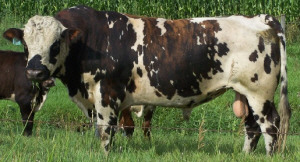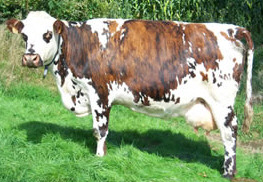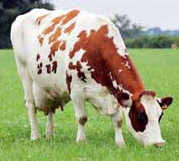



Normande
History
The Normande originated in Normandy, France from cattle brought to the country by Viking conquerors in the 9 th and 10 th centuries. For over a thousand years these cattle evolved into a dual purpose breed to meet the milk and meat needs of the residents of northwestern France.The present herd book in France was started in 1883. Though the breed was decimated by the Allied invasion of Normandy during World War II, there are currently 3 million Normandes in France. Their present role in France is to provide rich milk for the cheese industry while maintaining their excellent carcass quality. In other parts of the world such as the US, this breed has been primarily bred for beef but now there is a strong push for it to be used for dairy too.
 Photo courtesy of CR Normande Cattle, http://home.earthlink.net/~crcattle/index.html |
While the Normande has always been used for dairy, it has always presented strong dual-purpose qualities. In France, the Normande has always been known for its unsurpassed marbling quality, flavour and tenderness, and regularly wins blind tests for its taste. A special label for Normande meat enjoys great popularity in major supermarkets. In the US, Normande bulls have won growth tests at various test stations and carcasses have often ranked first at major beef shows.
Characteristics
The Normande is a red and white cow with occasional sometimes widespread areas of brown hair. Typically, the brown hair has the look of tiger stripes, or brindles, interspersed with the red spots, and there is some degree of balance between the three different hues. However, one colour often dominates, and there is a different name for the dominance of each colour.The representative Normande is red and white (with brown brindles), this is said to be “blond” others are “quail” - when the white dominates, “brindled” - predominantly brown and “trouted” which is a multitude of brown spots on the skin underneath white hair. Some bulls appear black but it is really brown hair, the Normande is homozygous red breed.
Calves do not display their brindles until a few weeks after birth, and altogether, Normande cattle tend to darken as they age.
Normandes are a medium frame size breed with most cows weighing 1,200 to 1,500 lbs. and bulls 2,000 to 2,400 lbs. They possess excellent body depth and spring of rib while maintaining exceptional body length. The cattle are also very clean fronted and carry a strong topline.
 Photo courtesy of the British Normande Cattle Society , www.britishnormandecattle.co.uk |
Because of the breed's high muscle mass to bone ratio and their small heads, the Normande has a high percentage yield at slaughter. The carcass is very lean but marbles readily and purebred Normande steers will easily grade choice at 1,250 lbs. The Normande breed won’t produce bulging rear quarters of cheap ground round but will increase the length and width of the top priced loin area cuts.
Statistics
Comparative
Growth RatesRecent bull tests have shown that this rapid growth rate will continue on high roughage feed. Normande bulls have topped the St. Croix Valley Bull Test at River Falls, Wisconsin in both years that they've been entered. In 1991 a Normande bull set an all time station record 4.93 lb. ADG and also had a 3.64 lb. WDA. The second place bull that year was also a Normande. In the 1992 test a Normande bull again topped the field with a 4.68 lb. ADG and a 3.49 lb. WDA. The 140 day test annually features 100 bulls from 8 to 10 different beef breeds fed a corn silage based high roughage ration. Studies in France have documented 5.0 feed conversion rates on the same type of diet.
In the 1990 and 1991 Montana 4-H Steer of Merit Carcass Contests, three 7/8 Normande steers placed in the top 10 out of the 1,000 steers entered annually including crossbreds. A 1991 Normande steer had a 16.2 in. rib eye, a 0.15 in. backfat, and a yield grade of 0.99.
North American Normande Association
Normande cows on high forage feeding systems average between 14,000 and 15,000 lbs of milk per lactation at 3.6 % protein and 4.4 % fat. Many cows produce more than 22,000 lbs and some reach 30,000 lbs. These results do not reflect the genetic originality of the breed: more than 90 % of the individuals carry the B Kappa Caseine gene and 82 % of AI Bulls have the BB Genotype. The levels of casein beta and kappa in the milk are known to improve the curdling quality of the milk for cheese manufacturing (speed and firmness of gel). In addition, Normande milk presents favorable calcium/phosphate ratio and casein miscella of small diameter, all of which result in yields of cheese 15 to 20 % higher depending on the type of fabrication/manufacture.
www.normandegenetics.com
TRIAL IN CASTLELYONS
Three years ago Waterford Co-Op decided to look at ways of helping their suppliers improve profit margins on their farms. Three batches of heifers were bought in, Normande, Montbeliarde, and High RBI Dutch Holsteins. Their performances were measured alongside the Castlelyons animals. Cows calved down in Spring of '96'. Milk yield in 1997 for Normande is heading for over 1,000 gals. and with protein levels in the region of 3.6 percent on 500 kgs meal. The trial work being carried out by Waterford also looks at the financial implications of each breed from the average Waterford supplier based on 80 acres with 42,000 gallon quota and male progeny carried to beef. In estimating the profit implications, the following assumptions were made, dual purpose cattle achieving a factory price premium of £100 over ordinary Freisiens; Dutch cattle carrying a price penalty of £30 per head over own breed and no butterfat levy imposed. The comparisons show that the Normande herd provide for and increase in net profit of £6,277, the Montbeliarde herd increase was £4,796 and the high RBI herd increase was £1,748 over own bred cattle.
Irish Normade Dual Purpose Cattle Breed Society
Distribution
Normandes have been exported world-wide but have received their greatest acceptance in South America where they were introduced in the 1890's. Total numbers there now exceed 4 million purebreds plus countless Normande crossbreds. Columbia alone has 1.6 million purebreds with the rest mainly in Brazil, Ecuador, Paraguay and Uruguay. They are also growing in countries such as Madagascar, the US, Mexico, Belgium, Switzerland, Great Britain and Ireland.References (the above information was cited from the following sites)
normandeassociation.com
www.normandegenetics.com
www.ansi.okstate.edu
www.britishnormandecattle.co.uk
CR Normande Cattle
Irish Normade Dual Purpose Cattle Breed Society


